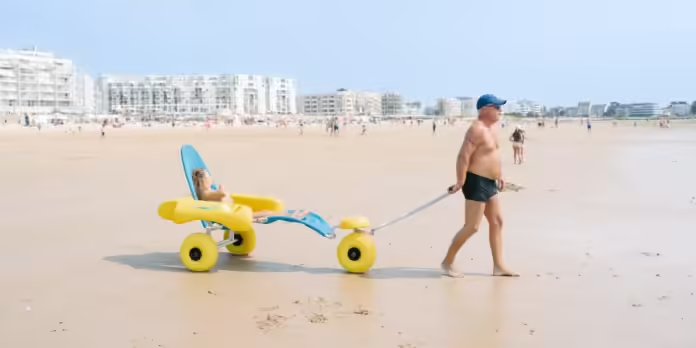
On the Atlantic coast of France, summer vacations are becoming more inclusive thanks to the country’s network of accessible beaches, known under the “Handiplage” label.
Awarded to 150 beaches across the nation, the label guarantees people with reduced mobility access to the sea, along with adapted facilities that promote independence and dignity. In Pornichet, a coastal town near Saint-Nazaire, families gathered recently to enjoy the warm August sun.
Among them was 22-year-old Elise Arnaud, who was able to swim in the open water using a Tiralo, an amphibious wheelchair equipped with two bright yellow floats. Nestled in its hammock seat, Elise floated comfortably as her mother and stepfather swam beside her.
For her mother, Virginie Jéhanno, the Tiralo represents more than convenience—it symbolizes freedom. “The Tiralo means we don’t have to carry her, it gives us a break,” she explained.
The family, accustomed to carrying Elise over dunes and uneven trails during trips in Brittany, said the beach’s accessibility transformed their holiday experience.
Libraires Beach in Pornichet features a range of adapted services: mat walkways leading into the water, gently sloping access ramps, dedicated parking spaces, and showers designed for wheelchair users.
For many families, these facilities allow for a day at the beach without the physical and emotional strain often associated with travel. Catherine, another visitor who has brought her 53-year-old son Jean-Michel to the beach for a decade, recalled earlier struggles.
“I remember the old system of ‘the slope,’ when we had to call a police officer for help,” she said. “Now, it’s wonderful. We can enjoy the beach like everyone else.” Still, she pointed out areas for improvement, such as mats that sometimes shift during peak summer months, making wheelchair movement more difficult.
The Handiplage initiative was developed to normalize beach holidays for people with disabilities. By offering amphibious wheelchairs like the Tiralo, which can be rolled from dry sand straight into the sea, it eliminates the barriers that once excluded many families from coastal recreation.
Local authorities have also invested in infrastructure, including renovated ramps and designated parking, to ensure accessibility from arrival to departure.
Officials note that visitor numbers to accessible beaches are rising each year. Families often arrive early to secure limited parking and spend the entire day enjoying the beach with picnics. Advocates believe the increasing popularity underscores the importance of continuing investments in inclusive tourism.
For many, these beaches represent more than a holiday—they embody equality and the right to leisure. As Jéhanno reflected, “It’s not just about Elise enjoying the water. It’s about us, as a family, being able to share these moments together.”
Across France, from Brittany to the Mediterranean, accessible beaches are helping to reshape the way society views disability—making inclusion not an exception, but a norm.
This article was created using automation technology and was thoroughly edited and fact-checked by one of our editorial staff members